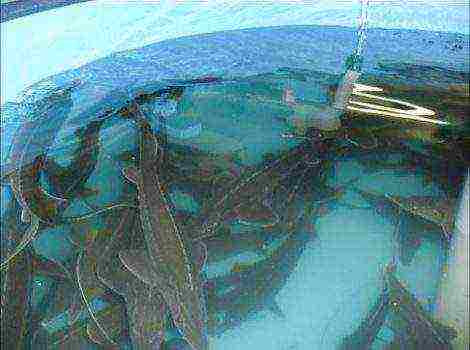Content
- 1 In the open field
- 2 A flower in a greenhouse
- 3 Plant in the pot
- 4 Where to buy alstroemeria
- 5 And a little about secrets ...
- 6 Outdoor cultivation
- 7 When is the best time to plant flowers
- 8 How to choose Peruvian lily flowers for planting
- 9 Types and varieties of alstroemeria
- 10 Planting alstroemeria in open ground
- 11 Caring for flowers after planting
- 12 Preparing for winter
Alstroemeria is a perennial rhizome plant. It has several names - Inca lily, Peruvian lily, Alstroemeria, Alstroemeria, Alstroemeria. Many species, varieties, hybrids are known, differing from each other in the shape and color of flowers, as well as in height.
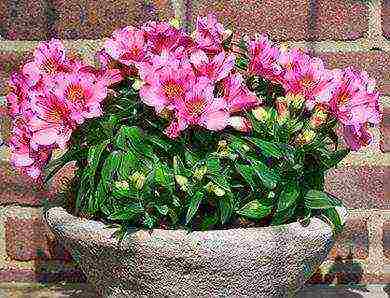 Several erect flexible stems, ending in an inflorescence, grow from the rhizome of alstroemeria. The flowers are funnel-shaped, multi-colored, with stripes or contrasting strokes, in structure they resemble a lily or an orchid, depending on the variety. The leaves are elongated, "twisted", ie. the top side is on the bottom and vice versa. These are the features of alstroemeria. The photo demonstrates this well.
Several erect flexible stems, ending in an inflorescence, grow from the rhizome of alstroemeria. The flowers are funnel-shaped, multi-colored, with stripes or contrasting strokes, in structure they resemble a lily or an orchid, depending on the variety. The leaves are elongated, "twisted", ie. the top side is on the bottom and vice versa. These are the features of alstroemeria. The photo demonstrates this well.
Most of the tall hybrids and varieties are grown in greenhouses. This is a highly productive crop, the cut flower stalks of which can stand in a vase for up to three weeks and open all the buds.
Breeders have also bred undersized forms and varieties. Alstroemeria at home can be grown as a pot culture. Its height ranges from 20 cm to 40 cm. Large flowers up to 7 cm in diameter appear in summer. The most popular are the Dutch varieties Camilla, Sarah, Ella with white, salmon, pink flowers, respectively.
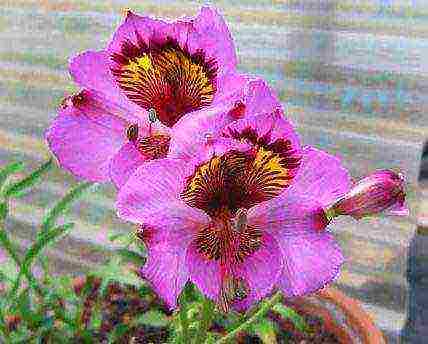 Alstroemeria grows better at home in diffused bright lighting. The temperature of the content should not fall below 5 ° C throughout the year. Flowering should be preceded by a period of 15 ° C for 3 weeks. With the appearance of buds, the temperature regime must be maintained at a level of 18 ° C.
Alstroemeria grows better at home in diffused bright lighting. The temperature of the content should not fall below 5 ° C throughout the year. Flowering should be preceded by a period of 15 ° C for 3 weeks. With the appearance of buds, the temperature regime must be maintained at a level of 18 ° C.
Watering is necessary moderately constantly, since the plant does not have a pronounced dormant period. Alstroemeria at home requires a transplant, when the roots will master the entire volume of the pot and come out of the drainage holes. It is preferable to replant in spring, in extreme cases - after flowering. With a strong growth of the rhizome, it must be divided. At least 10 stems (eyes) should be left on each part. If there is damage, foci of decay, they need to be cut out with a sharp knife, and the sections should be treated with something disinfecting, drying.
Alstroemeria at home can be propagated by seeds, if they can be purchased (they, as a rule, are not formed on hybrids). Seeds are sown in the spring 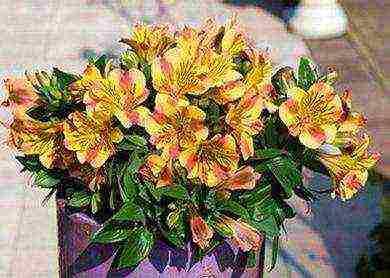 container with loose soil. They need to be pressed a little into the substrate and sprinkled a little. Moisten the crops and create a mini-greenhouse (cover with glass or film). Seedlings appear in 3 weeks. Seedlings bloom not earlier than in the second year.
container with loose soil. They need to be pressed a little into the substrate and sprinkled a little. Moisten the crops and create a mini-greenhouse (cover with glass or film). Seedlings appear in 3 weeks. Seedlings bloom not earlier than in the second year.
Alstroemeria is demanding on nutrition. Care includes weekly feeding. It is advisable to alternate feeding with organic and mineral fertilizers. During the budding period, nitrogen fertilization should be stopped.
It should be noted that the plant is poisonous, contains the toxin tulipalin. It is better to work with it with gloves, since irritation may occur if the toxin gets on the skin. Alstroemeria at home is a danger to cats, which may start vomiting and diarrhea if the toxin enters the body, because cats love to chew on plants on the windowsills.
Alstroemeria. South African beauty, who recently settled in our latitudes.The flower most of all resembles a lily of miniature size, but on each stem, not two or three, but up to 15 graceful buds are formed. Despite the seeming complexity, alstroemeria can be grown at home and you can quite cope with it.
Alstroemeria. South African beauty, who recently settled in our latitudes. The flower most of all resembles a lily of miniature size, but on each stem, not two or three, but up to 15 graceful buds are formed. Despite the seeming complexity, alstroemeria can be grown at home and you can quite cope with it.
In the open field
Alstroemeria blooms by June, spreading curved petals and flower beds. However, in order for the plant to lay flower buds by this time, it is necessary to plant it on flower beds in time.
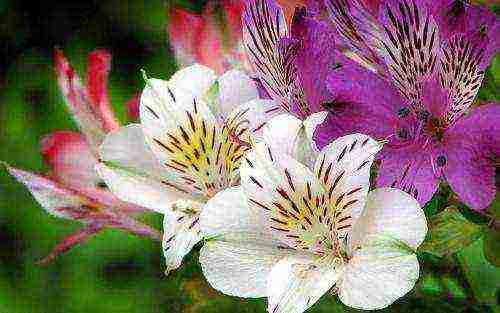
Landing
Alstroemeria is planted in May, when the soil warms up enough and the threat of recurrent frosts has passed.
- A place... Choose a planting site where the flower will be protected from strong gusts of wind and the scorching sun. Alstroemeria needs sunlight, but their intensity can destroy the flower and it will stop growing and blooming. Therefore, the best choice is partial shade.
- The soil... Neutral or slightly acidic. Drainage is required! Like all bulbs, alstroemeria is afraid of stagnant water in the soil from which its roots and onions can rot.
- Watering... Regular, especially if there is no rain. Try not to overflow the flower beds, but also do not make your beauty thirsty - she will drop the buds.
Alstroemeria bulbs are planted in the usual way: they are buried in the soil by three of their heights and covered with earth. Remember to water your flower garden after planting.
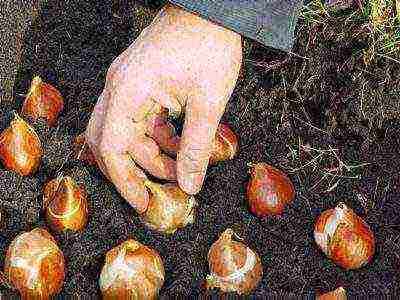
Care
Caring for alstroemeria is quite simple and does not require special agronomic knowledge.
- Flower beds... They must be mulched - this will help to retain moisture in the soil and protect the roots from overheating.
- Flowers. They are removed after they are tied up - this will help to extend the flowering time of the entire bush.
- Cut - produced as the buds dissolve. Cut alstroemerias stay in a vase for two weeks and look very elegant.
- Top dressing... It is applied under the tuber (humus, compost) during planting. In the future, if the plant is not dug up for the winter, it is necessary to feed the flower in spring and autumn. If home alstroemeria lacks nutrients, its leaves will turn yellow. Therefore, pay attention to the color of the foliage, ideally - it is dark green.
- Shelter... It is imperative because the flower is thermophilic. In the northern regions, the bulbs must be dug up for the winter, dried and stored in a basement in a dark, dry place until spring. Warmth comes - drop off again.
Growing alstroemeria can be complicated by pests. Delicate stems and leaves love to feast on: spider mites, caterpillars, slugs, flower thrips. At the first signs of the appearance of these pests, processing must be done.
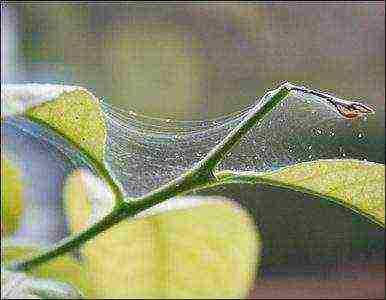
A flower in a greenhouse
The greenhouse method of growing alstroemeria allows you to get luxurious flowers at any time of the year. Many people build their business on this - after all, alstroemeria is used to compose wedding bouquets and is fabulously good in any composition. Gardeners grow it for sale, and if you want to plant a flower for trial, do it without hesitation.
The soil. Must be fertile and well-drained. Do not forget that the flower does not like moisture stagnation.
Lighting... At least 12 hours a day, so when growing alstroemeria in a greenhouse in winter, be sure to supplement it.
Temperature. + 16 + 18 degrees is enough for the plant to bloom, so you do not need to heat up your winter garden unnecessarily.
Reproduction. You can collect seeds and use them for planting. But if you want to get flowers earlier, divide the bush. Alstroemeria reproduces by dividing the bushes, just carefully divide the rhizome.

By the way: the older your home alstroemeria is, the easier it tolerates frost.Therefore, if you decide to transfer a flower from the greenhouse to open ground, then it can winter in it, without digging it out for the cold season.
Plant in the pot
Do you want to get a luxurious flower on the windowsill? Plant alstroemeria in a pot and it will decorate your home, regardless of the season.
- Place the drain on the bottom.
- Fill with soil on top.
- Plant an onion or two or three seeds (just in case - suddenly one won't sprout).
- Water and cover with plastic for a couple of days to create a greenhouse effect.
- After two days, remove the film and water the plant as the soil dries out.
Take care of the seedlings as usual: water, feed and protect from the scorching sun.

Where to buy alstroemeria
The level of e-commerce is quite high and you can buy alstroemeria on many trading platforms. We found several places and varieties:
Alstroemeria Passion... Planting material - bulbs. Sold in the Becker online store.
Alstroemeria revoluta... Planting material - seeds. Sold in the "Exotic.rf" store.
Alstroemeria "Funny moths"... Planting material - seeds. Sold in the "Seeds here" store.
Alstroemeria mix... Planting material - seeds (in a package - 3 pieces). Sold on the site "Seeds from Siberia".
Home alstroemeria is a luxurious flower that will decorate your garden, and with a rational approach, it will make a profit.
And a little about secrets ...
The story of one of our readers Irina Volodina:
I was especially depressed by the eyes, surrounded by large wrinkles plus dark circles and swelling. How to remove wrinkles and bags under the eyes completely? How to deal with swelling and redness? But nothing makes a person look older or younger than his eyes.
But how to rejuvenate them? Plastic surgery? Recognized - not less than 5 thousand dollars. Hardware procedures - photorejuvenation, gas-liquid pilling, radiolifting, laser facelift? Slightly more affordable - the course costs 1.5-2 thousand dollars. And when to find all this time? And it's still expensive. Especially now. Therefore, for myself, I chose a different way ...
Read the article >>
Popularly, this flower is also called the Peruvian lily and the flower of the Incas. Currently, alstroemeria is gaining more and more popularity. Flower shops offer a large selection of compositions with this beauty. She truly does not yield to the beauty of the traditional rose and lily. With a little strength and patience, you can admire its splendor in a flower bed or in your garden.
Outdoor cultivation
Many growers believe that the cultivation of the Peruvian lily is troublesome and obviously a failure. But this opinion is erroneous. In fact, plant alstroemeria on your own plot no harder than any other flower... You can prepare seedlings in advance or sow seeds in open ground when the last frost has passed.
The plant can also be planted in a pot. Balconies and loggias greened with its help look spectacular.
However, it should be borne in mind that this will require a spacious pot - the roots of the flower are long enough.
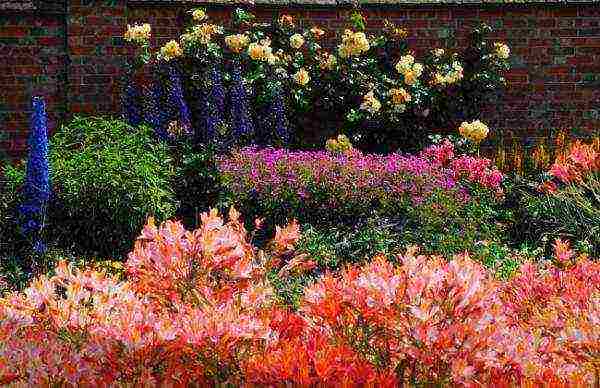 Alstroemeria in landscape design
Alstroemeria in landscape design
Alstroemeria is often used in landscape design. With its help, you can green curbs and paths. Tall varieties look great in the back rows of flower beds.
When is the best time to plant flowers
Alstroemeria is perennial flower... Like most perennials, in the first year it will not please you with flowering. As a rule, it begins to bloom in the second third year after planting with seeds, or a year later when planting tubers.
Seeds are recommended to be planted in open ground when stable warm weather is established, not earlier than the end of May - beginning of June... If the plant is grown in seedlings, the seeds are sown at the end of February. In early June, young seedlings are planted in a permanent place in the garden.
The tubers can be planted in spring, mid-April.If you want to achieve early flowering of the Peruvian lily, plant the rhizomes in late September - October.
Thus, the flower will wake up earlier, respectively, its flowering can be expected in the spring-summer period.
How to choose Peruvian lily flowers for planting
For the Peruvian beauty, there are only two landing options:
- seeds
- bulbs
If you prefer breeding seeds, they can be planted in open ground or germinated on a windowsill.
Depending on the chosen method, you need to approach the choice of material for planting with utmost attention and accuracy.
Alstroemeria is a rather thermophilic plant. Most of its varieties are adapted to warm climates with mild winters.
But as the popularity of this flower grows, scientists have developed varieties suitable for growing in the harsh Russian winters.
When choosing flowers for planting in your climatic conditions, this nuance must be taken into account. It is better to purchase planting material in specialized flower or garden stores.
When buying seedlings, you should pay attention to the appearance of the flower, is it susceptible to diseases and pests.
Types and varieties of alstroemeria
At the moment, there are more than a dozen types of alstroemeria - white, pink, purple and many others. Modern breeder scientists are working on the development of varieties suitable for cultivation in our climatic conditions. The most common plant varieties are discussed below.
- Brazilian... This is a tall plant variety, reaching a height of 1.5-2 m. The petals of the flower are spear-shaped, the inflorescences are red, and there are specimens with a bronze tint.
- Blood-flowered... This variety is distinguished by intensive growth, lush flowering. Inflorescences are bright red.
- Psittacina... A distinctive feature can rightfully be considered the flowers of the original color - orange with a green rim along the edge.
- Golden... The variety is frost-hardy enough. Delivers frosts down to -12 degrees. Flowers of various shades - from lemon yellow to red-orange. The plant is tall, reaching 1.5 m in height.
- Nano... The variety is low, only 10 cm tall. It blooms profusely, the inflorescences are colored golden with black specks.
Planting alstroemeria in open ground
When planting a Peruvian lily from seed it is recommended to use the seedling method... Before planting, seeds are kept in a damp cloth on the refrigerator shelf for about a month before planting. The optimum temperature during this period will be 2-4 degrees Celsius. Then the prepared seeds are planted in a container under a film or glass. After the emergence of seedlings, the greenhouse is gradually opened.
When the third leaf appears, the seedlings dive. At the end of May, seedlings are planted in open ground. To do this, you need to correctly choose the landing site.
For alstroemeria, a sunny warm place will be suitable, partial shade is possible. It is important to protect the chosen place from drafts and strong winds.
The soil for planting must be loose and nutritious... To do this, dig up the selected area the day before the planned planting of plants. It is recommended to add rotted manure, compost, peat to the soil.
Alstroemeria planting process:
- dig up the holes, the distance between them should be at least half a meter;
- lay drainage on the bottom, you can use river pebbles;
- then add a handful of compost;
- put the plant in the hole, sprinkle it with earth on top, compact it a little with your hands;
- water the young plant abundantly;
- from above it is recommended to mulch the soil with peat or sawdust.
If you decide to propagate an existing flower dividing the rhizome, you need to dig the plant out of the ground. Then divide the bush into 2-3 parts, process the cuts with crushed coal. The resulting bushes can be planted in the ground.
With this method of reproduction, young plants take root for a long time, therefore they require constant care and close attention.
Caring for flowers after planting
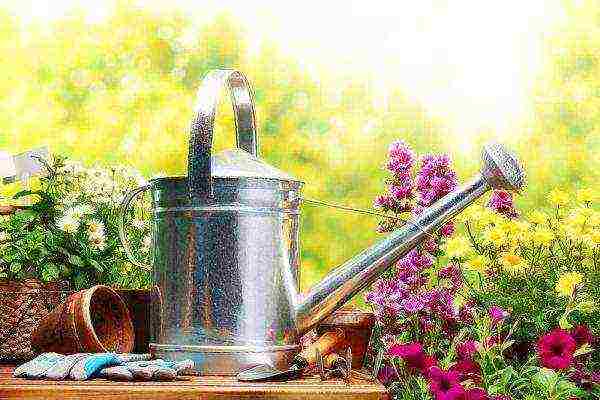 Watering alstroemeria should be considered carefully
Watering alstroemeria should be considered carefully
You need to be especially careful about watering alstroemeria. She categorically does not tolerate waterlogging.
If the soil looseness is insufficient and the soil is rather heavy, the roots of alstroemeria start to rot... And it is extremely difficult to stop this process. Use mulching to keep the plant in loose soil.
Top dressing of the Peruvian lily when growing in a pot is not required at all. But in the open field they are necessary.
Add once a week:
- before budding potash mineral fertilizers;
- during the budding and flowering period, mineral fertilizers for flowering (with a low nitrogen content).
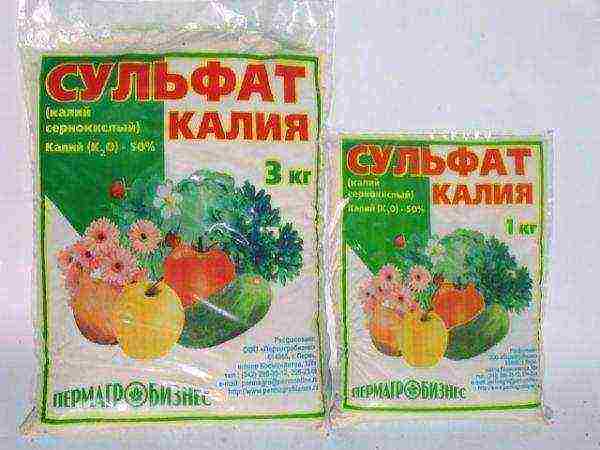 Potash fertilizer for alstroemeria
Potash fertilizer for alstroemeria
Organic fertilizers can be used only in small quantities and well rotted so as not to burn the roots of the plant.
Preparing for winter
Mature plants quite frost-resistant compared to young people. In southern latitudes, they can winter outdoors.
In temperate latitudes, it is necessary to snatch alstroemeria for the winter. For this, the stems and leaves of the flower are cut off, leaving no more than 8-10 cm above the soil surface. Then they cover with sawdust, foliage, spruce branches. From above, you can close the Peruvian lily with captivity and throw mulch.
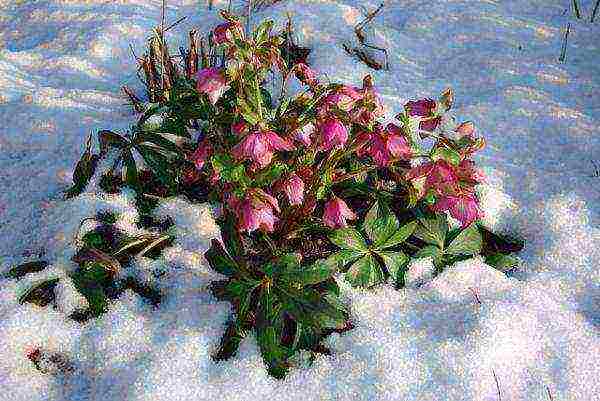 Adult alstroemeria can winter outdoors
Adult alstroemeria can winter outdoors
If the plant is still young, or a particularly harsh winter is expected, alstroemeria can be dug up like a chrysanthemum.
You can store the dug out bush in your home cellar until spring.
Alstroemeria is a rather exotic plant for our latitudes. But do not be afraid of growing a beauty in your own garden. If you follow all the rules of care and recommendations for plant maintenance, you will soon get a brightly flowering plant.
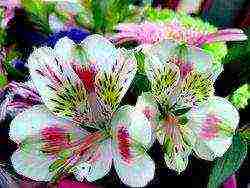
Surely many of us, when choosing a bouquet, paid attention to small delicately-colored flowers that outwardly resemble lilies, but are significantly inferior to them in size. The name of these cute flowers is alstroemeria. Alstroemeria refers to herbaceous perennial plants that came to us from the tropics of South America. But, despite such an exotic origin, it is quite possible to grow it in our latitudes. The intricacies of the technology of growing alstroemeria in the garden will be discussed in this article.
Alstroemeria - planting and care
Since alstroemeria is a tropical plant, certain conditions must be created for it to grow and bloom successfully.
- Alstroemeria should be planted in a well-lit and drained area, leaving 30 cm gaps between the plants and burying them into the soil by 20-25 cm.
- Alstroemeria is very demanding on the ambient temperature. During the period of budding and flowering, the comfortable temperature for it is approximately + 16 ° C. When the soil warms up to a value above + 22 ° C, alstroemeria stops flowering, putting all its strength into the formation of powerful tubers.
- It is necessary to water this capricious beauty with a certain degree of caution, since overflow is very dangerous for her and can cause the death of the plant: in the summer, as a result of it, root decay can begin, and in the fall, alstroemeria can freeze out.
- Monthly care for alstroemeria must necessarily include 3-4 feeding with complete mineral fertilizers with a high potassium content. As soon as buds begin to form on alstroemeria, the nitrogen component must be completely excluded from the top dressing.
- Alstroemeria needs a special shelter for the winter. At the same time, young plants must be dug up for the winter and stored together with an earthen lump until spring in a cool dry place. Older alstroemeria bushes can be left to winter in the open field, carefully covering them with tar, dry branches and leaves.
Alstrometry - varieties
There are many varieties and hybrids of this wonderful flower.But the most common are the following:
- alstroemeria golden - has yellow-orange flowers and reaches a height of 95 cm;
- Alstroemeria Peruvian - cold-resistant, great for growing outdoors;
- alstroemeria Brazilian lily - a tall variety, reaching a height of 1.5-2 meters;
- blood-flowered alstroemeria - a variety characterized by lush inflorescences (about 15 flowers) and fleshy rhizomes;
- Alstroemeria parrot lily is a fast-growing variety with the ability to grow rapidly.
Alstroemeria - growing from seeds
There are two ways to grow alstroemeria: from seeds and by dividing the rhizome. When growing alstroemeria from seeds, flowering should be expected no earlier than three years later. You can plant seeds both directly into the open ground, and grow seedlings from them. For seedlings, seeds are sown in late February-early March, placing them in small pots and covering them with plastic wrap. Within a month, the pots with seedlings are hardened at a temperature of + 5 ° C. And in open ground, seedlings are transplanted at the end of May, when the danger of night frosts finally disappears. For planting seedlings, it is better to choose a warm, but not hot day, and a time when direct sunlight will not fall on the site. Immediately after planting, the area with alstroemeria must be thoroughly watered and mulched so that the soil retains moisture for as long as possible.
Alstroemeria is also grown in pots at home.


